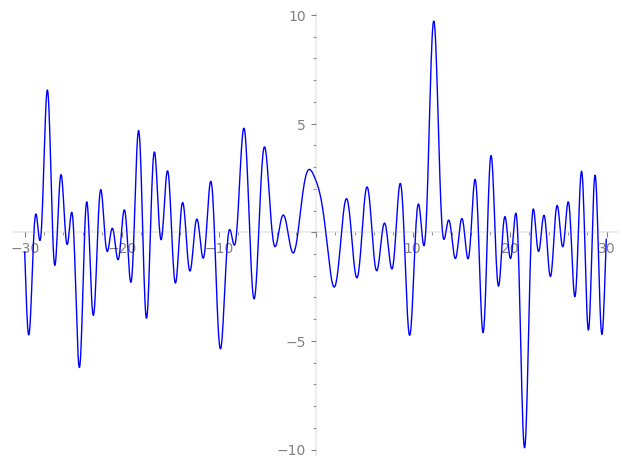| L(s) = 1 | + (0.513 − 0.707i)2-s + (1.26 + 0.410i)3-s + (0.381 + 1.17i)4-s + (−0.780 − 1.07i)5-s + (0.939 − 0.682i)6-s + (−0.169 + 2.64i)7-s + (2.68 + 0.874i)8-s + (−0.999 − 0.726i)9-s − 1.16·10-s + 1.64i·12-s + (4.91 + 3.57i)13-s + (1.77 + 1.47i)14-s + (−0.545 − 1.67i)15-s + (−3.39 + 2.46i)17-s + (−1.02 + 0.333i)18-s + (−0.939 + 2.89i)19-s + ⋯ |
| L(s) = 1 | + (0.363 − 0.499i)2-s + (0.729 + 0.236i)3-s + (0.190 + 0.587i)4-s + (−0.349 − 0.480i)5-s + (0.383 − 0.278i)6-s + (−0.0641 + 0.997i)7-s + (0.951 + 0.309i)8-s + (−0.333 − 0.242i)9-s − 0.367·10-s + 0.473i·12-s + (1.36 + 0.990i)13-s + (0.475 + 0.394i)14-s + (−0.140 − 0.433i)15-s + (−0.824 + 0.598i)17-s + (−0.242 + 0.0786i)18-s + (−0.215 + 0.663i)19-s + ⋯ |
\[\begin{aligned}\Lambda(s)=\mathstrut & 847 ^{s/2} \, \Gamma_{\C}(s) \, L(s)\cr =\mathstrut & (0.800 - 0.599i)\, \overline{\Lambda}(2-s) \end{aligned}\]
\[\begin{aligned}\Lambda(s)=\mathstrut & 847 ^{s/2} \, \Gamma_{\C}(s+1/2) \, L(s)\cr =\mathstrut & (0.800 - 0.599i)\, \overline{\Lambda}(1-s) \end{aligned}\]
Particular Values
| \(L(1)\) |
\(\approx\) |
\(2.28109 + 0.758820i\) |
| \(L(\frac12)\) |
\(\approx\) |
\(2.28109 + 0.758820i\) |
| \(L(\frac{3}{2})\) |
|
not available |
| \(L(1)\) |
|
not available |
\(L(s) = \displaystyle \prod_{p} F_p(p^{-s})^{-1} \)
| $p$ | $F_p(T)$ |
|---|
| bad | 7 | \( 1 + (0.169 - 2.64i)T \) |
| 11 | \( 1 \) |
| good | 2 | \( 1 + (-0.513 + 0.707i)T + (-0.618 - 1.90i)T^{2} \) |
| 3 | \( 1 + (-1.26 - 0.410i)T + (2.42 + 1.76i)T^{2} \) |
| 5 | \( 1 + (0.780 + 1.07i)T + (-1.54 + 4.75i)T^{2} \) |
| 13 | \( 1 + (-4.91 - 3.57i)T + (4.01 + 12.3i)T^{2} \) |
| 17 | \( 1 + (3.39 - 2.46i)T + (5.25 - 16.1i)T^{2} \) |
| 19 | \( 1 + (0.939 - 2.89i)T + (-15.3 - 11.1i)T^{2} \) |
| 23 | \( 1 - 3.47T + 23T^{2} \) |
| 29 | \( 1 + (-6.52 + 2.12i)T + (23.4 - 17.0i)T^{2} \) |
| 31 | \( 1 + (3.30 - 4.55i)T + (-9.57 - 29.4i)T^{2} \) |
| 37 | \( 1 + (0.927 + 2.85i)T + (-29.9 + 21.7i)T^{2} \) |
| 41 | \( 1 + (0.939 - 2.89i)T + (-33.1 - 24.0i)T^{2} \) |
| 43 | \( 1 + 7.61iT - 43T^{2} \) |
| 47 | \( 1 + (-9.14 - 2.96i)T + (38.0 + 27.6i)T^{2} \) |
| 53 | \( 1 + (-1.61 - 1.17i)T + (16.3 + 50.4i)T^{2} \) |
| 59 | \( 1 + (-6.91 + 2.24i)T + (47.7 - 34.6i)T^{2} \) |
| 61 | \( 1 + (-2.45 + 1.78i)T + (18.8 - 58.0i)T^{2} \) |
| 67 | \( 1 + 11.9T + 67T^{2} \) |
| 71 | \( 1 + (0.809 - 0.587i)T + (21.9 - 67.5i)T^{2} \) |
| 73 | \( 1 + (2.09 + 6.46i)T + (-59.0 + 42.9i)T^{2} \) |
| 79 | \( 1 + (-2.49 + 3.43i)T + (-24.4 - 75.1i)T^{2} \) |
| 83 | \( 1 + (7.01 - 5.09i)T + (25.6 - 78.9i)T^{2} \) |
| 89 | \( 1 + 18.5iT - 89T^{2} \) |
| 97 | \( 1 + (3.30 - 4.55i)T + (-29.9 - 92.2i)T^{2} \) |
| show more | |
| show less | |
\(L(s) = \displaystyle\prod_p \ \prod_{j=1}^{2} (1 - \alpha_{j,p}\, p^{-s})^{-1}\)
Imaginary part of the first few zeros on the critical line
−10.44072170301463880363011415822, −8.973578491767362353088069061225, −8.735099619896502319308755986634, −8.151473433622200228550101583539, −6.80498627722931252129835361165, −5.87730553295522230214589677569, −4.49059364947667084930902852628, −3.80710124804519557142996743233, −2.86743343599349336288601334555, −1.82859326544296834606246369919,
1.03726206510059759214087888523, 2.65812231094512639241693690811, 3.66689973731201271729524880498, 4.77499584082406168431366260086, 5.81030011200834335106859615989, 6.85540109301688134960469889497, 7.32144083508173355351433830125, 8.263497735206417413781678707895, 9.099005062589329648941725710678, 10.29669040363713655922063918234

